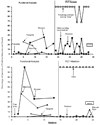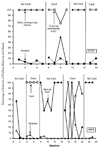Analysis of Mand Selection across Different Stimulus Conditions
- PMID: 20204077
- PMCID: PMC2831754
- DOI: 10.1353/etc.0.0086
Analysis of Mand Selection across Different Stimulus Conditions
Abstract
We conducted a three-phase study to evaluate the use of mands and the occurrence of problem behavior for 2 children with developmental disabilities. During Phase 1, a functional analysis identified the variables maintaining problem behavior. During Phase 2, functional communication training was implemented within a concurrent schedules design. The children were reinforced for using either a novel mand (communication card) or other existing mands (vocal speech, manual signs) that were not specifically trained but were observed to be part of the children's existing repertoire. We then conducted an assessment of mands and problem behavior across different stimulus conditions (card absent, card present) within an ABAB design (Phase 3). Results showed that during Phase 2, problem behavior decreased and participants used the card more frequently than they used other existing mands. Phase 3 showed that problem behavior remained low across both stimulus conditions. When the card was absent, the children used other existing mands; when the card was present, they primarily used the card. These results suggested that the presence of a communication card may function as a discriminative stimulus for a specific topography of manding, but that training with the card did not inhibit the use of other mands when the card was absent.
Figures


Similar articles
-
Assessment of mand selection for functional communication training packages.J Appl Behav Anal. 2002 Fall;35(3):295-8. doi: 10.1901/jaba.2002.35-295. J Appl Behav Anal. 2002. PMID: 12365744 Free PMC article.
-
Evaluation of a vocal mand assessment and vocal mand training procedures.J Appl Behav Anal. 2004 Summer;37(2):129-43; quiz 143-4. doi: 10.1901/jaba.2004.37-129. J Appl Behav Anal. 2004. PMID: 15293633 Free PMC article.
-
RESURGENCE OF MANDS FOLLOWING FUNCTIONAL COMMUNICATION TRAINING.Rev Mex Anal Conducta. 2015 Sep;41(2):166-186. Rev Mex Anal Conducta. 2015. PMID: 26640311 Free PMC article.
-
Mand compliance as a contingency controlling problem behavior: A systematic review.J Appl Behav Anal. 2021 Jan;54(1):103-121. doi: 10.1002/jaba.758. Epub 2020 Sep 2. J Appl Behav Anal. 2021. PMID: 32880964
-
Some Dimensions of Mand Variability and Implications for Research and Practice.Anal Verbal Behav. 2021 Apr 26;37(1):123-145. doi: 10.1007/s40616-021-00144-7. eCollection 2021 Jun. Anal Verbal Behav. 2021. PMID: 34395169 Free PMC article. Review.
Cited by
-
Assessing Acquisition of and Preference for Mand Topographies During Functional Communication Training.Behav Anal Pract. 2015 Aug 18;9(2):165-8. doi: 10.1007/s40617-015-0083-y. eCollection 2016 Jun. Behav Anal Pract. 2015. PMID: 27606246 Free PMC article.
-
A Practitioner's Guide for Selecting Functional Communication Responses.Behav Anal Pract. 2022 Apr 12;16(1):65-75. doi: 10.1007/s40617-022-00705-9. eCollection 2023 Mar. Behav Anal Pract. 2022. PMID: 37006421 Free PMC article. Review.
References
-
- Browning RM. A same-subject design for simultaneous comparison of three reinforcement contingencies. Behaviour Research and Therapy. 1967;5:237–243. - PubMed
-
- Charlop-Christy MH, Carpenter M, Le L, LeBlanc LA, Kellet K. Using the picture exchange communication system (PECS) with children with autism: Assessment of PECS acquisition, speech, social- communicative behavior, and problem behavior. Journal of Applied Behavior Analysis. 2002;35:213–231. - PMC - PubMed
-
- Derby KM, Fisher WW, Piazza CC, Wilke AE, Johnson W. The effects of noncontingent and contingent attention for self-injury, manding, and collateral responses. Behavior Modification. 1997;22:474–484. - PubMed
Grants and funding
LinkOut - more resources
Full Text Sources
